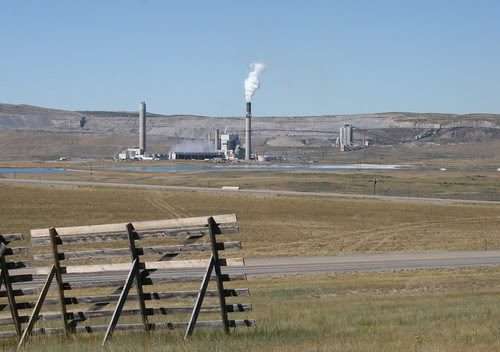PacifiCorp, TerraPower Evaluating Deployment of Up to Five Additional Natrium Advanced Reactors
Regulated utility PacifiCorp has launched a joint study with nuclear technology firm TerraPower to evaluate the feasibility of deploying up to five additional Natrium pool-type sodium fast reactors (SFRs) and integrated energy storage systems at retired coal plant sites in the utility’s service territory by 2035.
The joint study “will evaluate, among other things, the potential for advanced reactors to be located near current fossil-fueled generation sites, enabling PacifiCorp to repurpose existing generation and transmission assets for the benefit of its customers,” PacifiCorp and TerraPower said in a joint statement on Oct. 27. “The location of future Natrium plants will be thoroughly explored through this study process, and both companies will engage with local communities before any final sites are selected,” they said.
The announcement is a major advancement for Natrium, an advanced reactor design developed by TerraPower and GE Hitachi Nuclear Energy (GEH) that integrates molten salt energy storage and a unique energy system architecture. TerraPower and GEH are part of a consortium spearheading a much-watched 500-MWe demonstration of the reactor’s technology at PacifiCorp’s retiring 600-MW coal and gas–fired Naughton Power Plant in Kemmerer, Wyoming, which is backed with $2 billion in funding from the Department of Energy’s (DOE’s) Advanced Reactor Demonstration Program (ARDP). The pioneering commercial-scale demonstration is expected to be operational within the next six years—by 2028—aligning with the ARDP schedule, as mandated by Congress.

A Big Step for Coal-to-Nuclear Conversion
The joint study’s focus on repurposing coal plants echoes a focus that has been promoted widely across the power space recently. On Sept. 13, three major national laboratories—Argonne National Laboratory, Idaho National Laboratory, and Oak Ridge National Laboratory—issued a report that suggests 157 retired coal plant sites and 237 operating coal plant sites would make good candidates for a coal-to-nuclear transition. Eighty percent of these coal plants would also make good candidates to host advanced reactors smaller than 1 GW. “For the recently retired plant sites evaluated, this represents a capacity potential of 64.8 GWe to be backfit at 125 sites. For the operating plant sites evaluated, this represents a capacity potential of 198.5 GWe to be backfit at 190 sites,” the report says.
The report concludes that coal-to-nuclear conversions offer myriad benefits. Along with revitalizing communities affected by coal plant retirements, coal-to-nuclear conversions present an opportunity to repurpose coal infrastructure, including transmission lines, switchyards, cooling ponds or towers, and civil infrastructure. The DOE study suggests that reusing coal infrastructure could slash construction costs by 15% to 35%.
PacifiCorp, an Oregon–headquartered regulated utility that is owned by Berkshire Hathaway Energy, has mulled how advanced nuclear could replace its substantial 5.2-GW coal fleet since at least 2020. Coal made up 53% of the company’s 11.7 GW generating capacity as of December 2021. The company currently has ownership interests in 22 coal units at nine power plants—all built before 1986—in Wyoming, Utah, Colorado, and Montana. It also holds interests in coal mines that support its coal plants.
However, according to the company’s most recently integrated resource plan (issued in March 2022), PacifiCorp plans to retire or convert all its coal plants to natural gas by 2039. “Driven in part by ongoing cost pressures on existing coal-fired facilities and cost-effective new resource alternatives, of the 22 coal units currently serving PacifiCorp customers, the preferred portfolio includes retirement of 14 of the units by 2030 and 19 of the 22 units by the end of the planning period in 2040,” the company says. In addition to coal retirements, the company’s preferred portfolio reflects 1.6 GW of natural gas retirements through 2040.
As significantly, assuming the Natrium demonstration is fruitful, the company’s “least-cost, least-risk” portfolio envisions integrating 1,000 MW of “additional advanced nuclear resources” over the long term. The updated IRP also notably suggests that PacifiCorp could finalize commercial agreements for the Natrium project by the end of 2022. If the Natrium demonstration isn’t included in a future portfolio, one scenario suggests PacifiCorp would consider adding more solar co-located with storage but risk ramping up utilization of its fossil-fueled resources by up to 3%, depending on the price-policy scenario.
A Potentially Major Natrium Expansion
In a statement on Thursday, PacifiCorp noted the joint study with TerraPower will serve as a crucial first step. “The study will allow us to explore a carbon-free, dispatchable energy resource that could provide reliable power to our customers,” said Gary Hoogeveen, president and CEO of Rocky Mountain Power, a PacifiCorp division. “This is just a first step, as advanced nuclear power needs to be evaluated through our resource planning processes as well as receive regulatory approval. But it’s an exciting opportunity that advances us down the path to a net zero energy future.”
TerraPower said the joint study will serve as “a tangible example of the promise advanced nuclear brings to utilities serious about leading the nation’s energy transition.” TerraPower President and CEO Chris Levesque also suggested that community acceptance will significantly matter when deciding where to site future plants. “We have been impressed and humbled by our work with the Kemmerer community and PacifiCorp. We look forward to evaluating new potential sites for Natrium plants that have the same energy expertise and capabilities as our demonstration site,” he said.
Both PacifiCorp and TerraPower noted that federal support for advanced nuclear deployment “as part of a suite of solutions aimed at achieving carbon-free goals” have buoyed nuclear’s prospects. “With the passage of the Inflation Reduction Act, the bipartisan Infrastructure Investment and Jobs Act, and recent studies on the opportunities of a coal-to-nuclear energy transition, the role for advanced nuclear is clear,” the companies said. “TerraPower and PacifiCorp remain committed to bringing the Natrium technology to market and providing reliability and stability to the grid as well as to energy-producing communities.”
—Sonal Patel is a POWER senior associate editor (@sonalcpatel, @POWERmagazine).